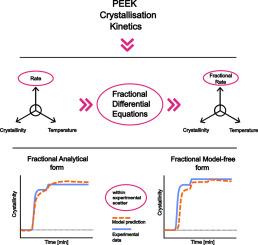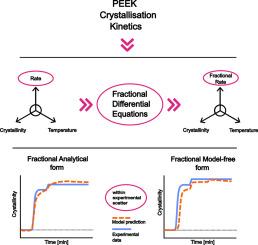用分数阶微分方程模拟PEEK结晶动力学
IF 4.5
2区 化学
Q2 POLYMER SCIENCE
引用次数: 0
摘要
高性能热塑性复合材料的结晶过程是复杂的,影响性能,如强度和韧性。在热塑性复合材料制造过程中,如过度成型,材料经历了一个复杂的热历史。工艺优化需要对材料性能进行全面的描述。解决这一问题的模型必须预测在任意冷却循环下的结晶度变化和过程的历史依赖性,并具有明确的参数识别。聚醚醚酮(PEEK)的差示扫描量热法(DSC)显示,动态和等温数据在结晶度/结晶速率/温度空间上存在差异,挑战了传统模型。利用卡普托导数,开发了一个分数率模型来校准两个数据集。提出了两种分数阶动力学模型形式:一种是利用结晶度和温度的威布尔分布函数在分数阶空间拟合数据;另一种采用分段曲面拟合和插值。这些模型通过斜坡驻留测试进行了测试,并以5%的误差范围预测了结晶度。这种灵活的方法适用于热塑性塑料及其复合材料,在制造环境中优化工艺,如过度成型和增材制造。研究数据包含在“Veyrat Cruz-Guzman, Maria;Ivanov, Dmitry(2025),“使用分数阶微分方程的PEEK结晶动力学建模”,Mendeley数据,V1, doi: 10.17632/xxb7rpm8fj.1本文章由计算机程序翻译,如有差异,请以英文原文为准。


Modelling of PEEK crystallisation kinetics using fractional differential equations
The crystallisation process of high-performance thermoplastic composites is complex, affecting properties such as strength and toughness. During thermoplastic composite manufacturing, such as over-moulding, the material undergoes a complex thermal history. Process optimisation requires a versatile description of material behaviour. Models to address this must predict crystallinity changes at arbitrary cooling cycles and the process's history dependence, with clear parameter identification. Differential Scanning Calorimetry (DSC) on polyether ether ketone (PEEK) showed discrepancies between dynamic and isothermal data in the crystallinity/crystallisation rate/temperature space, challenging conventional models. A fractional rate model, using the Caputo derivative, was developed to align both datasets. Two fractional kinetics model forms were proposed: one fitted data in the fractional space using Weibull distribution functions of crystallinity and temperature; the other used piecewise surface fit and interpolation. These models were tested against ramp dwell tests and predicted crystallinity with a 5 % error margin. This flexible approach is applicable to thermoplastics and their composites, in a manufacturing context for optimising processes such as over-moulding and additive manufacturing.
Research data is included in “Veyrat Cruz-Guzman, Maria; Ivanov, Dmitry (2025), “Modelling of PEEK Crystallisation Kinetics Using Fractional Differential Equations”, Mendeley Data, V1, doi: 10.17632/xxb7rpm8fj.1”
求助全文
通过发布文献求助,成功后即可免费获取论文全文。
去求助
来源期刊

Polymer
化学-高分子科学
CiteScore
7.90
自引率
8.70%
发文量
959
审稿时长
32 days
期刊介绍:
Polymer is an interdisciplinary journal dedicated to publishing innovative and significant advances in Polymer Physics, Chemistry and Technology. We welcome submissions on polymer hybrids, nanocomposites, characterisation and self-assembly. Polymer also publishes work on the technological application of polymers in energy and optoelectronics.
The main scope is covered but not limited to the following core areas:
Polymer Materials
Nanocomposites and hybrid nanomaterials
Polymer blends, films, fibres, networks and porous materials
Physical Characterization
Characterisation, modelling and simulation* of molecular and materials properties in bulk, solution, and thin films
Polymer Engineering
Advanced multiscale processing methods
Polymer Synthesis, Modification and Self-assembly
Including designer polymer architectures, mechanisms and kinetics, and supramolecular polymerization
Technological Applications
Polymers for energy generation and storage
Polymer membranes for separation technology
Polymers for opto- and microelectronics.
 求助内容:
求助内容: 应助结果提醒方式:
应助结果提醒方式:


